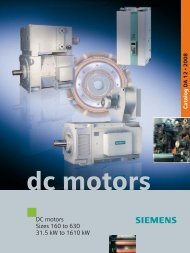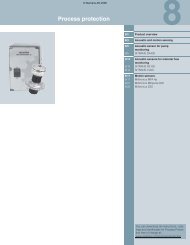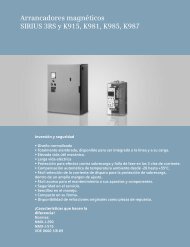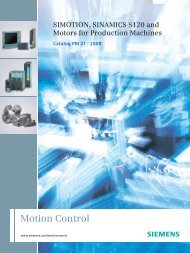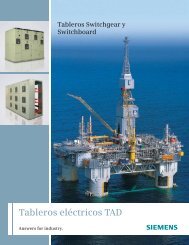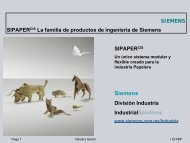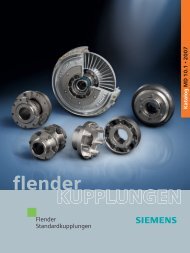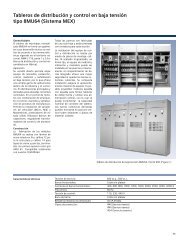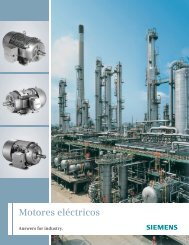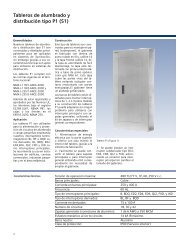SITRANS F flowmeters - Industria de Siemens
SITRANS F flowmeters - Industria de Siemens
SITRANS F flowmeters - Industria de Siemens
Create successful ePaper yourself
Turn your PDF publications into a flip-book with our unique Google optimized e-Paper software.
© <strong>Siemens</strong> AG 2009<strong>SITRANS</strong> F <strong>flowmeters</strong><strong>SITRANS</strong> F US■ FunctionOperating PrincipleThe <strong>SITRANS</strong> FUS1010 system is a transit-time ultrasonic meterthat provi<strong>de</strong>s exceptional performance using a non-invasiveclamp-on approach. Ultrasonic transducers transmit and receiveacoustic signals directly though the existing pipe wall,where the fluid refraction angle is governed by Snell’s law of refraction.System information and selection gui<strong>de</strong>Clamp-on transducer mounted in a reflect configurationThe beam refraction angle is calculated as follows:sinθ = c / V φc = Velocity of sound in fluidV ϕ = Phase velocity (a constant in the pipe wall)The flowmeter automatically compensates for any change influid sound velocity (or beam angle) in response to variations inthe average transit-time between transducers A and B. By subtractingthe computed fixed times (within the transducers andpipe wall) from the measured average transit-time, the meter canthen infer the required transit-time in the fluid (T Fluid ).The Sound waves traveling in the same direction as flow (T A,B )arrive earlier than sound waves traveling against the direction offlow (T B,A ). This time difference (Δt) is used to compute the lineintegrated flow velocity (v) as shown in the equation below:v = V ϕ / 2 ⋅ Δt / T FluidOnce the raw flow velocity is <strong>de</strong>termined, the fluid Reynoldsnumber (Re) must be <strong>de</strong>termined to properly correct for fully<strong>de</strong>veloped flow profile. This requires the entry of the fluid’s kinematicviscosity (visc) as shown in the equations below, where Qrepresents the final flow profile compensated volumetric flowrate.Re = Di ⋅ v / visc ⋅ Q = K(Re) ⋅ ( π / 4 ⋅ Di 2 ) ⋅ vv = Flow velocityvisc = μ / ρ = (dynamic viscosity / <strong>de</strong>nsity)K(Re) = Reynolds flow profile compensationIn all wetted type ultrasonic <strong>flowmeters</strong> the meter constants areconfigured prior to leaving the factory. As this is not possible withclamp-on meters, the settings must be ma<strong>de</strong> by the customer atthe time of installation. These settings inclu<strong>de</strong> pipe diameter, wallthickness, liquid viscosity, etc.<strong>SITRANS</strong> Clamp-On meters that inclu<strong>de</strong> temperature sensingcan be configured to dynamically infer changes in fluid viscosityfor the purpose of computing the most accurate flow profile compensation(K Re ).Ultrasonic Transducer TypesTwo basic types of Clamp-On transducers can be selected foruse with the <strong>SITRANS</strong> FUS1010 flowmeter. The lower cost “universal”transducer is the most common type in the industry andis suitable for most single liquid application where the sound velocitydoes not vary much. This transducer type can be used onany sonically conductive pipe material (including steel) makingit well suited for portable survey applications. Universal transducersare selected based on the pipe diameter range alone, sowall thickness is not important to the selection process.The second transducer type is the patented Wi<strong>de</strong>Beam transducer(called high precision), which utilizes the pipe wall as akind of loudspeaker to optimize the signal to noise ratio and provi<strong>de</strong>a wi<strong>de</strong>r area of vibration. This makes this kind of transducerless sensitive to any change in the fluid medium.The Wi<strong>de</strong>Beam transducer is <strong>de</strong>signed for steel pipes, but canalso be used with aluminum, titanium and plastic pipe. It is thepreferred transducer for HPI and gas applications. Note that unlikethe universal type, this transducer selection is <strong>de</strong>pen<strong>de</strong>ntonly on the pipe’s wall thickness.Automatic Zero Drift Correction (ZeroMatic Path)When Wi<strong>de</strong>Beam transducers are installed in the “Reflect” mo<strong>de</strong>configuration shown below, the acoustic signal travels in two differentpaths between transducers A and B. One path “ACB”travels through the pipe wall and fluid, while the other path “AB”never enters the fluid medium.4This later path provi<strong>de</strong>s the meter with a reference signal thatis completely in<strong>de</strong>pen<strong>de</strong>nt of flow rate and can therefore beused as a measure of transducer “mis-match”. By continuallyanalyzing this pipe wall signal the FUS1010 meter can dynamicallycorrect for flow errors caused by zero drift.Multi-Channel FlowmetersFor improved flow profile averaging, redundancy, or better costper measurement, Clamp-On meters can be supplied with 1 or2 measurement channel, with 4 channel meters supplied as specialor<strong>de</strong>r.In the standard FUS, FUP, FUE systems, these channels can beinstalled on separate in<strong>de</strong>pen<strong>de</strong>nt lines or in a multi-beam installationas shown below. This choice is ma<strong>de</strong> during meter setup,where either a multi-beam (two beams on same pipe) or multichannelinstallation can be selected.March 2009<strong>Siemens</strong> FI 01 · 20094/235



